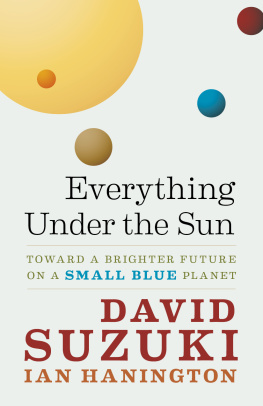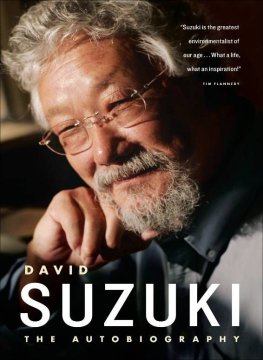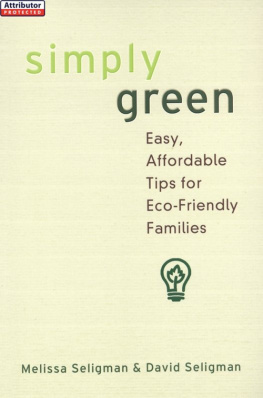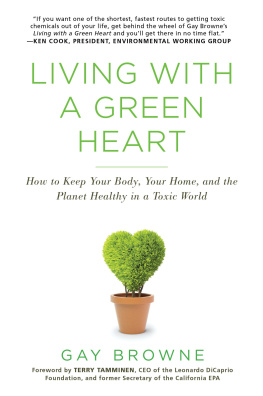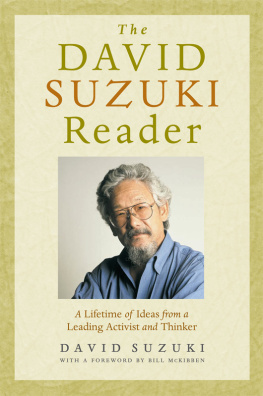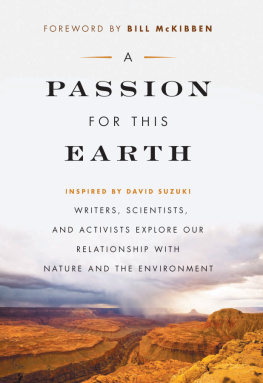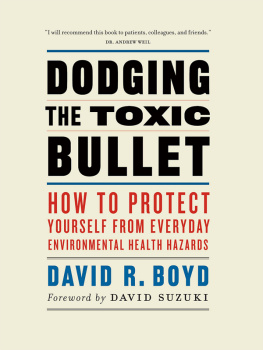DAVID SUZUKIS GREEN GUIDE
 DAVID
DAVID
SUZUKIS
GREEN GUIDE
DAVID SUZUKI & DAVID R. BOYD

Copyright 2008 by David R. Boyd and David T. Suzuki
08 09 10 11 12 5 4 3 2 1
All rights reserved. No part of this book may be reproduced, stored in a retrieval system or transmitted, in any form or by any means, without the prior written consent of the publisher or a licence from The Canadian Copyright Licensing Agency (Access Copyright).
For a copyright licence, visit www.accesscopyright.ca or call toll free to 1-800-893-5777.
Greystone Books
A division of Douglas & McIntyre Ltd.
2323 Quebec Street, Suite 201
Vancouver, British Columbia Canada V5T 4S7
www.greystonebooks.com
David Suzuki Foundation
2192211 West 4th Avenue
Vancouver, British Columbia Canada V6K 4S2
Library and Archives Canada Cataloguing in Publication
Boyd, David R., (David Richard)
David Suzuki's Green guide / David R. Boyd and David Suzuki.
Includes index.
ISBN 978-1-55365-293-9
1. Environmental protectionCitizen participationHandbooks, manuals, etc.
2. Sustainable livingHandbooks, manuals, etc.
3. Green productsHandbooks, manuals, etc.
I. Suzuki, David, 1936 II. Title. III. Title: Green guide.
TD171.7.B69 2008 363.7052 C2008-902674-8
Editing by Nancy Flight
Copy editing by Barbara Tomlin
Cover and text design by Jessica Sullivan
Printed and bound in Canada by Freisens
Printed on acid-free paper that is forest friendly (100% post-consumer
recycled paper) and has been processed chlorine free
Distributed in the U.S. by Publishers Group West
We gratefully acknowledge the financial support of the Canada Council for the Arts, the British Columbia Arts Council, the Province of British Columbia through the Book Publishing Tax Credit, and the Government of Canada through the Book Publishing Industry Development Program (BPIDP) for our publishing activities.
This book is dedicated to every person
worried about the Earth
who has ever wondered What can I do?
Contents

Acknowledgements

Thanks to all the good people at the David Suzuki Foundation and Greystone Books for supporting this book. In particular, we are grateful to Rob Sanders, Nancy Flight, Ann Rowan, Dominic Ali, and Barbara Tomlin. We would also like to thank all of the colleagues, friends, and family who reviewed parts of the manuscript and provided gentle but constructive criticism. And finally, a special thank you to Margot and Meredith for putting up with David B.s obsession with reducing his familys ecological footprint during the months of research and writing for this book.
DAVID SUZUKIS GREEN GUIDE

1

Help Wanted: Join the Sustainability Revolution
Imagination is more important than knowledge.
ALBERT EINSTEIN

What can I do? This is the question people inevitably ask when thinking about todays environmental problemsthe climate crisis, declining biological diversity, and toxic pollution. Its a short and simple question, but theres no easy answer (which is why we wrote this book). Everything we do has some kind of impact, but some decisions and actions are more important than others. Nearly all of us want to do the right thing when it comes to the environment, but few of us have the time or the specialized knowledge necessary to sift through the competing claims and mountains of information about the greenest choices. It can be confusing when we hear media reports suggesting:
Theres still scientific debate about the cause of climate change (theres not).
Its more eco-friendly to drive to the store than to walk (its not).
Its fine to buy a gas-guzzling Hummer rather than a hyper-efficient hybrid Toyota Prius (ridiculous).
This book cuts through the fog, identifying the most important actions we can take and how to get started. Knowledge plus motivation equals action.
THE ECOLOGICAL FOOTPRINT
For many people in North America, caught up in the trials and tribulations of day-to-day living, the state of the worlds climate, oceans, forests, soils, rivers, wildlife, and wetlands may seem remote. Yet the basic biological reality is that humans are still utterly dependent on the natural world and its ecological processes for our health, well-being, and prosperity. All humans need to breathe, eat, and drink, and its nature that provides us with fresh air, clean water, and the ability to grow food. All humans require a reasonably hospitable climate, and the interconnected web of natural systems regulates the planets climate and makes life on earth viable.
A prime example of this dependence is our reliance on insects for pollination of food crops. Indigenous people relied exclusively on wild species for pollination. Today, however, honeybees originally taken from Europe to North America pollinate about one-third of the crops eaten by Americans. These crops, ranging from almonds and apples to soybeans and strawberries, have a value of $15 billion annually. Various environmental problems, including the introduction of parasitic mites, caused a 50% decline in honeybee colonies between 1971 and 2006. Now the introduced honeybees are experiencing a sudden population crash labeled colony collapse disorder, causing additional losses of 30% to 70%. Although the cause of the problem is not known with certainty, various human disruptions are the prime suspects. Native North American bees are also experiencing extinctions, extirpations, and population declines. Decades ago Albert Einstein reportedly warned If the bee disappears from the surface of the earth, man would have no more than four years to live. No more bees, no more pollination, no more plants, no more animals, no more man. Today there are still no technological alternatives to animal pollinators.
While our individual actions may seem insignificant when viewed in isolation, the cumulative impact of billions of apparently benign actions is devastating. Scientists at the University of British Columbia in Canada created a concept called the ecological footprint in an effort to illustrate the connections between individual actions and global consequences. The ecological footprint measures how big a chunk of the planet is needed to produce the resources for, and assimilate the waste of, one person for a year. Ecological footprints include the dimensions of land and water required to produce crops, livestock, fish, wood products, and energy, as well as the area required to absorb the carbon dioxide produced by burning fossil fuels. The size of our individual ecological
 AN APPLES ECOLOGICAL FOOTPRINT
AN APPLES ECOLOGICAL FOOTPRINT


